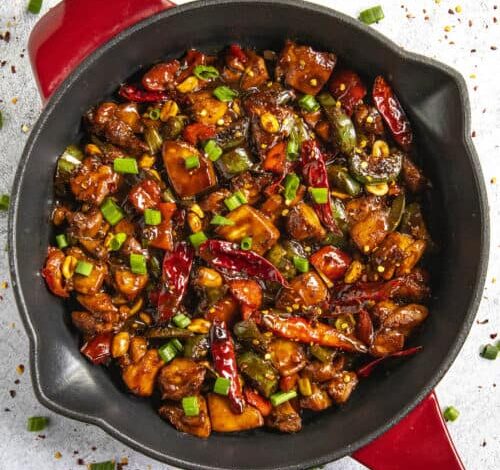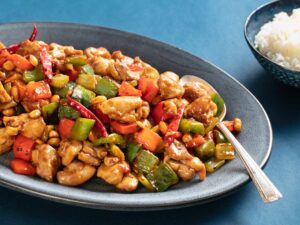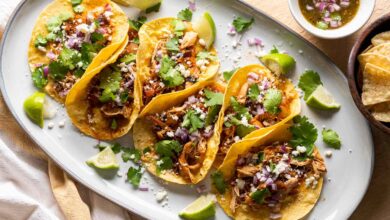Kung Pao Chicken Recipe
Kung Pao Chicken Recipe

Kung Pao Chicken Recipe Introduction:
Kung Pao Chicken is a classic Chinese dish renowned for its vibrant combination of flavors and textures. Originating from the Sichuan province, this dish is named after Ding Baozhen, a Qing Dynasty official known as “Kung Pao” or “Palace Guardian.”
The recipe features bite-sized chicken pieces stir-fried with a medley of crunchy vegetables, peanuts, and chili peppers. The sauce, a balanced blend of soy sauce, rice vinegar, and sugar, provides a tangy, slightly sweet, and savory flavor profile, while Sichuan peppercorns add a distinctive, aromatic spice.
Kung Pao Chicken is celebrated for its contrast of tender chicken, crispy peanuts, and the punchy heat of chili peppers, making it a popular and flavorful choice in Chinese cuisine. It’s typically served with steamed rice, offering a satisfying and well-rounded meal.

Kung Pao Chicken Recipe Overview:
Kung Pao Chicken is a well-balanced dish with a perfect blend of spicy, tangy, and sweet flavors, making it a staple in Chinese cuisine and a favorite among many.
Kung Pao Chicken Recipe Ingredients:
For the Chicken Marinade:
- Chicken Breast or Thighs: 500 grams, cut into bite-sized pieces
- Soy Sauce: 2 tablespoons
- Rice Wine or Dry Sherry: 1 tablespoon (optional, for deeper flavor)
- Cornstarch: 1 tablespoon (for tenderizing and coating)
For the Sauce:
- Soy Sauce: 2 tablespoons
- Rice Vinegar: 1 tablespoon (for tanginess)
- Sugar: 1 tablespoon (for a touch of sweetness)
- Hoisin Sauce: 1 tablespoon (adds depth and a hint of sweetness)
- Chicken Broth: 1/4 cup (for a savory base)
- Cornstarch: 1 teaspoon (mixed with 1 tablespoon water to make a slurry, for thickening)
For Stir-Frying:
- Vegetable Oil: 2-3 tablespoons (for cooking)
- Garlic: 3-4 cloves, minced
- Ginger: 1-inch piece, minced
- Dried Red Chilies: 6-8 (adjust to taste for heat level)
- Sichuan Peppercorns: 1-2 teaspoons (optional, for authentic flavor)
For the Vegetables:
- Bell Peppers: 1-2, diced (use a mix of colors like red, green, and yellow for visual appeal and flavor)
- Green Onions: 2-3, chopped (for garnish and flavor)
For Garnish:
- Roasted Peanuts: 1/2 cup (adds crunch and richness)
Additional Notes:
- Substitute for Rice Wine: If unavailable, use dry sherry or omit if preferred.
- Alternative Vegetables: You can add other vegetables like zucchini or mushrooms based on your preference.
- Adjusting Spice Levels: Use fewer or more dried red chilies and Sichuan peppercorns based on your heat tolerance.
These ingredients come together to create the iconic Kung Pao Chicken with its balance of spicy, tangy, and sweet flavors.
Kung Pao Chicken Ingredient Tips:
1. Chicken:
- Cut Choice: Use boneless, skinless chicken breast or thighs. Thighs are more flavorful and juicy, while breasts are leaner.
- Uniform Pieces: Cut the chicken into uniform bite-sized pieces to ensure even cooking.
2. Marinade:
- Soy Sauce: Use low-sodium soy sauce if you want to control the salt content.
- Rice Wine: If you don’t have rice wine, dry sherry or white wine can be used as a substitute.
- Cornstarch: Helps to tenderize the chicken and gives it a light coating for a better texture during stir-frying.
3. Peanuts:
- Roasted Peanuts: Use unsalted, roasted peanuts for the best crunch and flavor. Avoid raw or salted peanuts, which can affect the dish’s taste and texture.
- Toasting: If using raw peanuts, toast them lightly to enhance their flavor before adding them to the dish.
4. Vegetables:
- Bell Peppers: Use a mix of colors (red, green, yellow) for both visual appeal and a variety of flavors. Dice them uniformly for even cooking.
- Additional Vegetables: Feel free to add other vegetables like snow peas, mushrooms, or zucchini for extra texture and flavor.
5. Dried Red Chilies:
- Adjust Heat: The number of dried red chilies determines the spice level. Use fewer chilies for a milder dish or more for extra heat.
- Seeds: Remove seeds if you prefer a less spicy dish, as they contain most of the heat.
6. Sichuan Peppercorns:
- Authentic Flavor: These add a unique, aromatic spiciness and a numbing sensation. If unavailable, you can omit them, but they contribute significantly to the traditional flavor.
- Toast for Flavor: Toast Sichuan peppercorns lightly in a dry pan before using to enhance their flavor.
7. Sauce Ingredients:
- Hoisin Sauce: Adds a sweet and savory element. Ensure it’s fresh for the best flavor.
- Cornstarch Slurry: Mix cornstarch with water to create a slurry for thickening the sauce. Add it gradually to avoid lumps.
8. Oil:
- High Smoke Point: Use vegetable oil, peanut oil, or another oil with a high smoke point for stir-frying. This ensures a good sear without burning.
9. Garlic and Ginger:
- Fresh: Use freshly minced garlic and ginger for the best flavor. Pre-minced or powdered versions can be used in a pinch, but they lack the fresh, vibrant taste.
10. Garnishing:
- Green Onions: Chop and add them at the end of cooking for a burst of freshness and color.
- Serving: Serve Kung Pao Chicken hot with steamed jasmine rice or fried rice to complement its bold flavors.
Kung Pao Chicken Recipe Equipment Needed:
**1. Wok or Large Skillet:
- Purpose: Ideal for stir-frying due to its high sides and ability to distribute heat evenly. A large skillet can be used if a wok is not available.
**2. Cutting Board:
- Purpose: Provides a stable surface for chopping and dicing ingredients such as chicken, vegetables, and garlic.
**3. Sharp Knife:
- Purpose: For cutting the chicken into bite-sized pieces and dicing vegetables. A sharp knife ensures clean cuts and safer handling.
**4. Mixing Bowls:
- Purpose: For marinating the chicken and preparing the sauce. Use separate bowls to keep the ingredients organized.
**5. Measuring Spoons and Cups:
- Purpose: For accurately measuring sauce ingredients, oil, and seasonings.
**6. Garlic Press or Mince Tool:
- Purpose: To efficiently mince garlic if you prefer not to chop it manually.
**7. Wooden Spoon or Spatula:
- Purpose: For stirring and mixing the ingredients in the wok or skillet without scratching the surface.
**8. Small Bowl or Cup:
- Purpose: To mix the cornstarch slurry for thickening the sauce.
**9. Small Pan (Optional):
- Purpose: To toast Sichuan peppercorns and peanuts, if needed, to enhance their flavors before adding them to the dish.
**10. Tongs or Meat Fork:
- Purpose: For handling and turning the chicken pieces during stir-frying.
**11. Ladle or Serving Spoon:
- Purpose: For serving the Kung Pao Chicken once it’s cooked.
**12. Strainer (Optional):
- Purpose: To remove excess oil or solids if necessary, especially if you prefer a lighter dish.
**13. Serving Dish:
- Purpose: To present the finished Kung Pao Chicken attractively at the table.
Additional Tips:
- Non-stick or Well-seasoned Wok: A non-stick or well-seasoned wok helps prevent sticking and burning, making stir-frying easier.
- Heat-resistant Spatula: If using a non-stick wok, a heat-resistant spatula is recommended to avoid damaging the coating.
Having the right equipment will ensure that your Kung Pao Chicken is cooked efficiently and turns out delicious, with the perfect balance of flavors and textures.
Kung Pao Chicken Recipe Step-by-Step Instructions:
- Marinate the Chicken:
- In a mixing bowl, combine the chicken pieces with 2 tablespoons of soy sauce, 1 tablespoon of rice wine or dry sherry (if using), and 1 tablespoon of cornstarch.
- Mix well to coat the chicken evenly. Allow the chicken to marinate for at least 15 minutes.
- Prepare the Sauce:
- In a separate bowl, mix together 2 tablespoons of soy sauce, 1 tablespoon of rice vinegar, 1 tablespoon of sugar, 1 tablespoon of hoisin sauce, and 1/4 cup of chicken broth.
- Add 1 teaspoon of cornstarch mixed with 1 tablespoon of water to the bowl and stir to combine. Set aside.
- Toast Sichuan Peppercorns (Optional):
- If using Sichuan peppercorns, heat a small pan over medium heat. Add the peppercorns and toast them lightly until fragrant, about 1-2 minutes. Remove from heat and set aside.
- Heat the Wok or Skillet:
- Heat 2-3 tablespoons of vegetable oil in a wok or large skillet over medium-high heat.
- Cook the Chicken:
- Add the marinated chicken pieces to the hot oil. Stir-fry for about 5-7 minutes, or until the chicken is browned and cooked through. Remove the chicken from the wok and set aside.
- Stir-Fry Aromatics and Vegetables:
- In the same wok, add a little more oil if needed. Add minced garlic, ginger, and dried red chilies (and Sichuan peppercorns if using). Stir-fry for 1-2 minutes until fragrant.
- Add the diced bell peppers and continue to stir-fry for another 2-3 minutes until the peppers are tender but still crisp.
- Combine Chicken and Sauce:
- Return the cooked chicken to the wok. Pour the prepared sauce over the chicken and vegetables.
- Stir well to coat everything evenly with the sauce. Cook for an additional 2-3 minutes, or until the sauce has thickened and everything is well combined.
- Add Peanuts:
- Stir in the roasted peanuts and cook for another 1-2 minutes to incorporate them into the dish.
- Garnish and Serve:
- Garnish with chopped green onions. Serve the Kung Pao Chicken hot with steamed jasmine rice or fried rice.
Enjoy your flavorful and spicy Kung Pao Chicken, which combines tender chicken with crunchy peanuts and a tangy sauce for a satisfying meal!
Tips and Tricks:
**1. Marinate the Chicken Properly
- Tenderness and Flavor: Marinate the chicken with soy sauce, rice wine, and cornstarch for at least 15 minutes, or preferably for 1 hour, to enhance tenderness and flavor.
- Cornstarch Coating: The cornstarch helps create a slight coating on the chicken that gives it a nice texture during stir-frying.
**2. Choose the Right Peppers
- Dried Red Chilies: Use dried red chilies to add authentic heat. Adjust the number based on your spice preference. For less heat, remove the seeds before using.
- Sichuan Peppercorns: These add a unique numbing spice and aroma. Toast them lightly before using to enhance their flavor.
**3. Use Fresh Ingredients
- Garlic and Ginger: Use freshly minced garlic and ginger for the best flavor. Pre-minced or powdered versions lack the vibrancy of fresh ingredients.
**4. Control the Heat
- High Heat Stir-Frying: Ensure your wok or skillet is preheated on high heat before adding ingredients. This helps achieve the quick sear needed for stir-frying.
- Avoid Overcrowding: Cook the chicken in batches if necessary to avoid overcrowding the pan, which can cause steaming rather than stir-frying.
**5. Perfect the Sauce
- Thickening: Use a cornstarch slurry (cornstarch mixed with water) to thicken the sauce. Add it gradually and stir continuously to avoid lumps.
- Balance Flavors: Taste the sauce before adding it to the wok. Adjust the seasoning with more sugar, soy sauce, or vinegar as needed to balance the flavors.
**6. Toast Peanuts for Extra Crunch
- Enhance Flavor: Lightly toast the peanuts in a dry pan before adding them to the dish to bring out their nutty flavor and add extra crunch.
**7. Add Vegetables at the Right Time
- Vegetable Crispness: Add vegetables like bell peppers towards the end of cooking to keep them crisp. Overcooking can make them mushy.
**8. Monitor Sauce Reduction
- Sauce Consistency: If the sauce reduces too much, it can become too thick. If this happens, add a splash of chicken broth or water to adjust the consistency.
**9. Garnish for Freshness
- Green Onions: Add chopped green onions at the end of cooking or as a garnish to provide a burst of freshness and color.
**10. Serve Immediately
- Best Flavor: Kung Pao Chicken is best served immediately after cooking while it’s hot and the peanuts are still crunchy.
**11. Adjust for Dietary Preferences
- Gluten-Free: Use gluten-free soy sauce and hoisin sauce if you need a gluten-free version.
- Less Spicy: For a milder version, use fewer dried red chilies and omit the Sichuan peppercorns.
Serving Suggestions:
Kung Pao Chicken is a flavorful and versatile dish that pairs well with various sides. Here are some great serving suggestions to complement this spicy, tangy stir-fry:
**1. Steamed Jasmine Rice
- Classic Pairing: Serve Kung Pao Chicken over a bed of fluffy jasmine rice. The rice soaks up the flavorful sauce and balances the dish’s spice.
**2. Fried Rice
- Flavorful Alternative: For a more substantial meal, pair Kung Pao Chicken with fried rice. You can use vegetable, chicken, or shrimp fried rice for extra variety.
**3. Brown Rice
- Healthier Option: If you prefer a healthier option, serve the chicken with brown rice. Its nutty flavor complements the spicy chicken well.
**4. Asian Noodles
- Different Texture: Serve with steamed or stir-fried noodles like rice noodles, egg noodles, or soba. The noodles absorb the sauce and add a different texture to the meal.
**5. Chinese Pancakes
- Unique Side: Chinese pancakes (jianbing) are a fun alternative to rice. They can be used to scoop up the chicken or simply enjoyed alongside.
**6. Vegetable Sides
- Balanced Meal: Complement the dish with steamed or stir-fried vegetables like broccoli, bok choy, or snap peas for added freshness and crunch.
- Simple Stir-Fried Greens: A quick stir-fry of greens like spinach or Chinese broccoli can be a light and healthy addition.
**7. Soup
- Starter Option: Start your meal with a light soup such as hot and sour soup, egg drop soup, or miso soup to complement the main course.
**8. Spring Rolls
- Appetizer: Serve with vegetable or chicken spring rolls for a complete Asian-themed meal. They provide a crunchy contrast to the tender chicken.
**9. Dipping Sauces
- Extra Flavor: Offer additional dipping sauces like soy sauce, hoisin sauce, or a spicy chili sauce on the side for those who like extra flavor.
**10. Pickles
- Tangy Contrast: Serve with pickled vegetables or Asian-style pickles to provide a tangy contrast to the rich and spicy flavors of Kung Pao Chicken.
**11. Garnishes
- Fresh Herbs: Garnish with chopped fresh cilantro or green onions for a burst of freshness and color.
- Sesame Seeds: Toasted sesame seeds can add a nutty flavor and a bit of crunch.
These serving suggestions can help you create a well-rounded meal that complements the bold and spicy flavors of Kung Pao Chicken. Enjoy experimenting with these options to find your favorite combination!
FAQs:
1. Can I use a different type of meat for Kung Pao Chicken?
Answer: Yes, you can substitute chicken with other meats such as pork, beef, or even tofu for a vegetarian version. Just ensure the meat is cut into bite-sized pieces and adjust cooking times as needed. Marinate and cook them similarly to the chicken.
2. How can I make Kung Pao Chicken less spicy?
Answer: To reduce the heat, use fewer dried red chilies and remove the seeds. You can also omit Sichuan peppercorns if you prefer a milder flavor. Adjust the level of spice to your taste by gradually adding and tasting the dish as you cook.
3. Can I prepare Kung Pao Chicken in advance?
Answer: Yes, you can prepare Kung Pao Chicken in advance. Store it in an airtight container in the refrigerator for up to 3 days. Reheat thoroughly before serving. The dish may thicken as it cools, so you might need to add a splash of water or broth when reheating.
4. What can I use if I don’t have Sichuan peppercorns?
Answer: If Sichuan peppercorns are unavailable, you can omit them or use a small amount of ground black pepper or a pinch of red pepper flakes for added spice. However, Sichuan peppercorns add a unique, aromatic flavor that’s integral to the authentic taste.
5. How can I make Kung Pao Chicken gluten-free?
Answer: To make the dish gluten-free, use gluten-free soy sauce (often labeled as tamari) and ensure that the hoisin sauce is also gluten-free. Check all sauces and seasonings for gluten content to ensure they fit your dietary needs.





